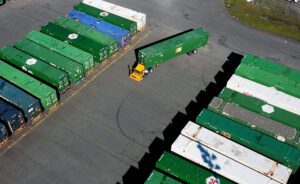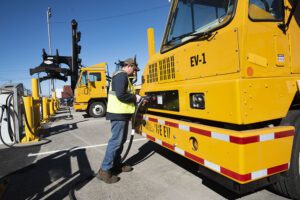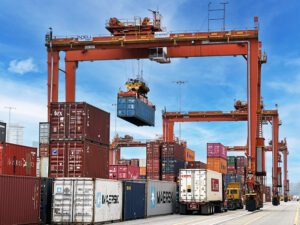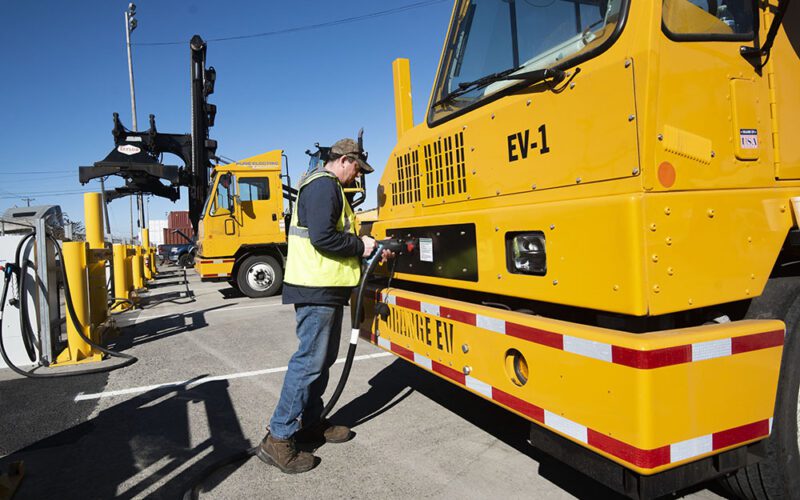
When it comes to cargo handling equipment, sustainability is the apparent path forward for West Coast seaports, both in terms of environmental innovation and funding.
From yard tractors and rubber-tired gantry cranes to ship-to-shore and roll-on/roll-off cranes, the next generation of equipment arriving at West Coast marine terminals is capable of operating on electric charging and/or alternative fuel sources.
But funding such innovation will be key to how well terminals move forward on cargo-handling equipment. That’s why port officials have been particularly bullish in going after that funding at the state and federal level to leverage private sector investment.
“There are record levels of grant funding to support our sustainability efforts,” Morgan Caswell, the Port of Long Beach’s air quality practices manager, told Pacific Maritime. “Mostly we were tapping into state funding programs, which have historically been robust. But this is really the first time we’re seeing the federal government ramp up their zero-emission efforts.”
The Los Angeles and Long Beach seaports, for example, anticipate receiving a piece of $1.2 billion in funding from the U.S. Department of Energy through California’s Alliance for Renewable Clean Hydrogen Energy Systems (ARCHES). The state program is intended to nurture hydrogen fuel goods movement projects.
The ports and their tenants would fund-match these types of projects, including those involving potential hydrogen fuel cell cargo-handling equipment.
Here’s a look at what types of cargo handling equipment are debuting or being planned at several terminals and seaports along the U.S. and Canadian West Coast.
SSA Marine
SSA Marine has been advancing its efforts to bring sustainability to its cargo-handling operations.
Through a joint venture with Matson Navigation Co. announced in November, SSA Marine introduced 33 new battery-electric yard tractors at the Port of Long Beach’s Pier C, the largest deployment of its type on the West Coast.
The new tractors, which replaced older equipment that needed gas and diesel, were funded in part with $50 million from the California Air Resources Board.
The joint venture included developers to build equipment and infrastructure that could handle cargo demands in Long Beach in partnership with Southern California Edison and the port.
The equipment, which can run in two shifts with a charge once a day, boosts by 20% the use of zero-emissions equipment at the Long Beach port.
Farther south, SSA Marine is also planning to introduce a half-dozen pieces of zero-emissions cargo handling equipment over the next 12 to 18 months at the Port of San Diego’s Tenth Avenue Marine Terminal, which recently finished the initial installation of the electrical infrastructure to support the equipment.
Funded in part through California’s Clean Off-Road Equipment voucher program, the 55,000-pound capacity Wiggins Yard eBull battery electric forklift is the first piece of zero-emissions equipment in service at the San Diego terminal and is among the biggest zero-emissions heavy-duty forklifts in service in the nation, SSA announced March 6.
Port of Los Angeles
The nation’s busiest seaport is bustling with cargo-handling equipment investments and demonstrations.
Some terminals are starting to test hydrogen fuel cell models. Yusen Terminals (YTI) took delivery of its first hydrogen fuel cell, rubber-tired gantry crane in January and soon plans to begin testing that equipment, Jacob Goldberg, an environmental specialist in the port’s Environmental Management Division, said.
Also, the port has been working with Fenix Marine Terminal since 2023 on a re-powered top handler that’s been very promising, he added.
APM Terminals is also investing in modern cargo-handling equipment.
In February, it announced that it spent nearly $1 million to turn 28 vehicles with combustion engines into new, all electric Volkswagen ID.4s that now operate at Pier 400 Los Angeles, while also installing a Level-3 dual-port DC fast charge station and four Level-2 dual port charging stations to sustain the fleet.
APM Terminals said it also intends to add four more Level-2 dual-port charging stations that the public can access.
Transitioning the fleet to electric is part of the terminal’s bigger goal to bring electrification to 100 vehicles for its terminal operations. Pier 400 is among five terminals taking part in APM’s worldwide decarbonization effort to pilot the electrification of port equipment.
“Pier 400 is taking proactive steps to decarbonize operations today with proven and available EV technology,” said Jon Poelma, managing director of APM Terminals Pier 400. “By taking the dream of electric fleets off the drawing board and putting them into the terminal, we’re able to reduce our environmental impact by up to 60 tons of annual tailpipe CO2 emissions. These are small but important steps to do our part, along with the contributions of our employees, partners, customers and community, to make the green transition a reality.”
At West Basin Container Terminal, demonstrations are expected to begin soon on a project to test a wireless charging system for 10 battery electric tractors from BYD Motors.
The project has two charging stations: a main installation of 10 chargers at a home base where the equipment is parked at the end of the day and two chargers near a break facility where the tractors can be replenished while workers are on their breaks.
Rather than plugging in, the wireless charging system would allow the tractors to pull over and sit on a charging pad, Goldberg said.
The project also includes a battery storage system for the tractors to help limit impact to the Los Angeles Department of Water and Power’s electrical grid.
Meanwhile, the two-charger site is complete while work on the main installation is nearly done, Goldberg said.
Once the full installation is finished and all the yard tractors are delivered in the next few months, the port plans to kick off a year of demonstrations.
“We’re really excited to see how that wireless charging system works in action,” Goldberg said.
Port of Long Beach
With millions in federal, state and local funding secured in 2023, the Port of Long Beach is closer to achieving its goal of zero-emission cargo handling equipment by 2030.
Roughly $101.7 million of the $224 million that the port received from the California State Transportation Agency is dedicated to zero-emissions cargo-handling equipment and infrastructure.
A mix of about 63 pieces of such equipment consisting of tractors, top handlers, heavy-duty forklifts and more are expected to be deployed at Long Beach Container Terminal, SSA at Pier J and SSA at Pier F, said Morgan Caswell, the port’s air quality practices manager.
As part of that grant, the port may fund up to 55 pieces of additional zero-emissions equipment, she added.
As part of its application submission, the port is also planning to create an incentive program, tentatively called the Zero Emissions Terminal Transformation Program with roughly $28.7 million in grant funding allocated to it, Caswell said.
“We knew there would be more deployments on the horizon as some of our terminals are finishing up their infrastructure master planning,” she stated. “We just wanted to get ahead of the game and have some dollars that we would be administering for future projects and focus on the equipment and the infrastructure.”
The port also was awarded a $30.1 million Port Infrastructure Development Program (PIDP) grant for the deployment of 60 battery electric tractors and other infrastructure at Long Beach Container Terminal.
“It’s nice to see many of our terminals are starting to see success through port-led grant applications and some of them are leading their own applications now, too, which is worth noting,” Caswell said.
“It really is going to have to take multiple stakeholders continuing to submit applications,” she added, “to really move the needle on this funding strategy, to be able to get all of these projects funded.”
The port is also partnering with some of its terminals on their infrastructure master plans.
“Infrastructure is easily the largest barrier to zero-emission deployments because it can take quite a bit of time to get adequate power to the terminal and then you need the terminal side infrastructure to also be upgraded,” Caswell explained.
Port of Oakland
Last spring, the Oakland Board of Port Commissioners agreed to amend the lease of terminal operator TraPac, paving the way for greener cargo-handling equipment at the terminal. It’s the first time the port has included sustainable container handling equipment upgrades in a terminal operator’s lease agreement.
TraPac’s plans include converting three rubber-tired gantry cranes from diesel to hybrid-diesel fuel, a 95% reduction in potential diesel emissions. The crane retrofitting is expected to be complete by the end of this year, depending on TraPac obtaining grant funding.
As a financial incentive, the port intends to reimburse TraPac up to 35% (or $945,000, whichever is less) of the retrofit costs.
TraPac also plans to pay for four new hybrid rubber-tired gantry cranes in late 2024, the port said.
“This landmark lease agreement will bring the port closer to its goal of achieving zero-emissions operations,” port Executive Director Danny Wan said in May. “We have multiple projects underway that are modernizing the seaport and building the Port of Oakland into a hub of zero-emissions innovations.”
Also, the port announced last July that it secured $119 million in state grant funding, with some of that money expected to fund the conversion of diesel-powered, cargo-handling equipment to zero-emissions equipment.
Northwest Seaport Alliance

In 2022, the Northwest Seaport Alliance welcomed to the Port of Tacoma’s South Intermodal Yard six all-electric, yard-handling pieces of equipment to help transfer containers to and from rail cars and container stacks, a first for the gateway.
The electric yard truck project was a $2.2 million endeavor between the Seaport Alliance, Tacoma Power and Rail Management Services (RMS). The project was supported by a $732,000 Diesel Reduction Act grant awarded to Seaport Alliance, which helped RMS pay for the electric yard trucks provided by electric heavy-duty truck firm Orange EV. Another $132,000 from Tacoma Power offset some of the project’s infrastructure costs.
The project is an example of efforts being made by NWSA to encourage acquisition of more sustainable cargo-handling equipment as part of its plans to meet zero-emissions goals by 2050.
Expanding on its efforts, the alliance has begun planning studies centered around the electrification of cargo-handling equipment, getting information from terminals about their fleets and working with the utility to see how much power it would take to support terminals.
“We know that there’s going to be huge power requirements associated with electrifying all these terminals,” said Seaport Alliance Air Quality and Sustainability Practices Project Manager Graham VanderSchelden.
The hope is to finish those studies in the first half of this year, VanderSchelden remarked. Once the studies are done, the NWSA intends to work with tenants and terminal operators on projects that could be ready for short-term implementation to capitalize on current and upcoming state and federal funding opportunities.
“If we’re successful in our grant efforts in the spring, you’ll see some announcements towards the end of this year,” he remarked.
In the long term, the studies are expected to give the alliance a roadmap for delivering the infrastructure that would be needed over time to comprehensively electrify the terminals, VanderSchelden added.
“It’s helping inform our own capital planning and then also helping to inform where there’s opportunities to be more collaborative between ourselves and the utility, perhaps leveraging those new relationships for more funding,” he said.
Meanwhile, NWSA’s Environmental Project Manager Rose Arsers is in the midst of scoping out a program that would help incentivize tenants to purchase zero-emissions equipment. One aspect – guidelines of what a scrap-and-replace incentive program would look like.
“There’s lots of funding opportunities coming online either now or in the near future and so we’re looking to some of those opportunities to help fund some of the incentives,” Arsers explained.
Sustainability is an important element to driving growth within the Seattle-Tacoma gateway, Seaport Alliance Chief Operating Officer Jeff Bellerud said.
“It goes beyond just our operations or our customer service,” he said. “We need to be stewards of the environment, and that is looking at all kinds of technology and figuring out what is going to be the next best thing to get us away from diesel equipment.”

Port of Vancouver, BC
In British Columbia, marine terminals at the Port of Vancouver have been making big investments in cleaner cargo-handling equipment.
Logistics company DP World is conducting a pilot project to decarbonize its fleet of rubber-tired gantry cranes at the seaport, with the company’s first hydrogen fuel cell system-powered version of the cranes operating there.
Last September, Chilliwack, B.C.-based industrial manufacturing and engineering firm TYCROP Manufacturing was chosen to lead the design and manufacturing of the pilot. There are plans to tap the region’s growing hydrogen sector for the endeavor, including Loop Energy as fuel cell supplier and HTEC for hydrogen fuel supply, according to TYCROP.
The TYCROP-designed dual-fuel system, powered by a pair of Loop Energy T505 fuel-cell structures, would be installed in DP World rubber-tired gantry cranes. Loop Energy’s hydrogen fuel cells were chosen for their “high fuel efficiency, TYCROP said.
Set to start in the second quarter of this year, the pilot would demonstrate how to electrify the company’s global fleet of 1,500 such cranes in phases.
“(Decarbonization) is a core focus for DP World, and we are proud to work with our local partners to deliver an innovative made-in-B.C. solution to reduce CO2 emissions from our Vancouver terminal operations,” DP World Vancouver General Manager Joel Werner said. “This vital pilot project aligns with DP World’s global commitment to becoming carbon neutral by 2040.”
DP World previously put in five zero-emission electric rail-mounted gantry cranes at its Centerm container terminal on the south shore of Burrard Inlet.
Meanwhile, GCT Global Container Terminals announced in November that it has committed to the Canadian government’s Net Zero Challenge of achieving zero emissions by 2050.
The terminal operator plans to build on its green investments by growing its light-duty fleet electrification with three electric vehicles, adding six new electric ship-to-shore cranes and funding low-emission container-handling equipment, GCT said.
New ship-to-shore cranes entering service for GCT all feature modern all-electric motors that help raise berth productivity and lower the amount of running hours needed to service vessels, according to the company.
GCT added that its efforts have resulted in lowering emissions intensity per container by nearly 20% across its operations.
“Taking on the Federal Net Zero Challenge reinforces our focus on environmentally responsible practices at our terminals,” GCT Global Container Terminals President and CEO Eric Waltz said. “As we continue to expand and increase capacity, sustainability will remain a core value.”
Additionally, the Vancouver Fraser Port Authority, which manages the Port of Vancouver, has been working with industry partners to test low- and zero-emission fuels and technologies at the port.
As part of the Low-Emission Technology Initiative, the port authority and the Province of British Columbia agreed to each invest $1.5 million toward transitioning to low-emission energy. It includes demonstrating battery-electric-powered terminal tractors and a crane powered by hydrogen.
KAREN ROBES MEEKS, a Southern California native, is an award-winning journalist with more than 20 years’ writing experience. Her articles have appeared in the Los Angeles Times, San Francisco Chronicle, Orange County Register and Long Beach Press-Telegram, where she worked as a reporter for nearly 14 years. Her work has been recognized by the California News Publishers Association, the Associated Press News Executives Council and the Los Angeles Press Club.

